May 10, 2021 --
Appreciating Windbreaks
We've had a stretch of pretty strong north winds but if one finds a
place out of the wind it can be almost warm. A few of the plants from the greenhouse have
ventured outside to start getting used to the outdoor environment, while
their less hardy friends stay inside because they don't think upper
40's is that warm. But those days are coming and soon they'll all be out
basking in the fresh air. Meantime the brave early ones find it quite cozy on the
south side of the wood shed where they can ignore that north wind.
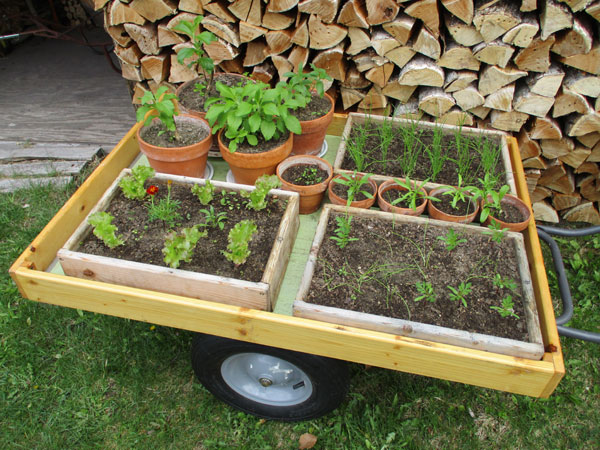
The plants aren't the only ones to appreciate a nice wind-break. Lilli
found herself a nice new spot to sit and survey her kingdom. She sat
there like that for quite some time before deciding all was well and she
might as well head on in for her afternoon siesta. Or maybe she just
needed a break from all that intense spring green.
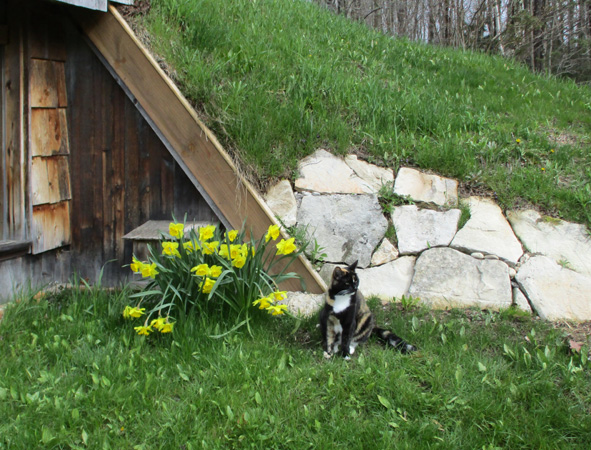
September
18, 2020 -
First Hard Freeze of the Season
Night before last there was mention of scattered frost, which meant
frost for sure in our frost-pocket little valley. It wasn't the first
we'd had this month so the blankets were ready at hand and the necessary
plants covered. It got down to 29 in the orchard, and would be warmer in
the garden near the still warm ground. All was well. But yesterday they
got a little more serious about it - Widespread Freeze - with possible
20's hinted. And a red warning box on the NOAA forecast page. That
wasn't really necessary - if you'd lived here long enough you could feel
it - but I certainly took them seriously. As usual I'd hoped for a few
more growing weeks since, as is often the case, it's supposed to warm
back up after this cold spell. But not to be, so yesterday, while Steve
went out to cut firewood, I harvested. And they were right - it got down
to 24 degrees out in the open. Cold enough!
A really nice full sweet pepper crop with many ripe, red peppers filled
up their spot along two walls of the root cellar, plants with their
fruit hung where the under-ripe peppers will continue to ripen and keep
surprisingly fresh for quite awhile. A small basket of cherry tomatoes
at various stages of ripe will brighten our salads for many weeks to
come. The grapes had done their best in spite of buds being frozen twice
in the spring, with a small crop with enough ripe for a batch of juice.
If there had been more I would have covered them but instead I
harvested. NEXT year I'll remember to cover them in the spring so they
can get that needed extra long growing season. Grapes are an iffy crop
here but I keep trying.
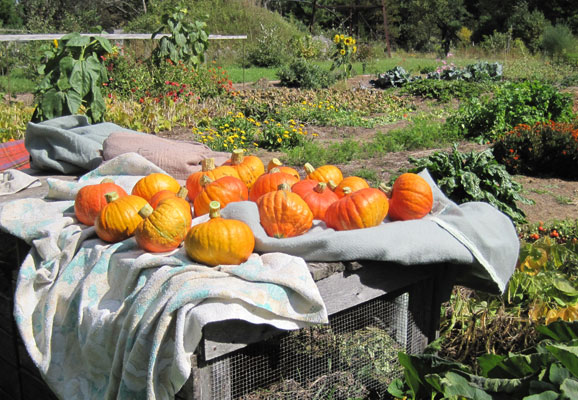 Squash
had a late start getting going this year, maybe due to the unusual
record heat so I didn't know if there would be any ripe ones. But I had
detected some orange amongst the very lush large leaves so I hoped.
Turns out there was no need to worry, they loved this over-hot summer
and made record time ripening. I think we'll have enough squash! There
were five not quite ripe good sized fruit left in the plants so I
double-blanket covered those to see if they can make it.
Squash
had a late start getting going this year, maybe due to the unusual
record heat so I didn't know if there would be any ripe ones. But I had
detected some orange amongst the very lush large leaves so I hoped.
Turns out there was no need to worry, they loved this over-hot summer
and made record time ripening. I think we'll have enough squash! There
were five not quite ripe good sized fruit left in the plants so I
double-blanket covered those to see if they can make it.
Of course, though the garden looks pretty wilted and done-in today,
there is still much out there - potatoes and carrots, parsley, spinach
and lettuce to move into the greenhouse when the cold really sets in.
Meantime, there will be many warm days yet, and likely frosts, and the
woodshed is cleaned out and ready to start filling. Autumn is a great
time of year.
June
29, 2020 -
Summer!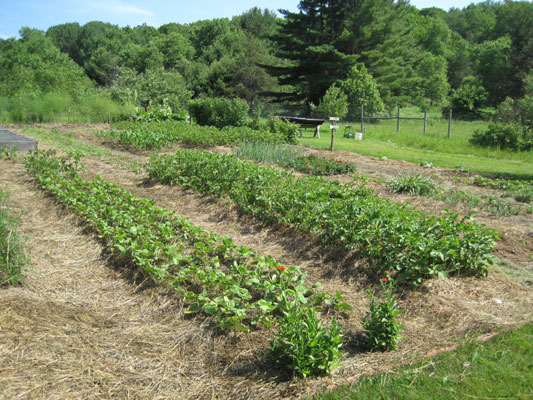
Summer for me begins when the garden is all planted, growing and
mulched, hopefully (and usually) by the end of June. And this year the
garden came through right on time; it's happily settled in for the
summer, feeding us well. But the coming "hot weather of July" that we
usually plan for is a bit hard to figure since we've been getting those
80's July temperatures since the end of May! A strange year indeed. It's
hard to guess just what July, and the rest of summer, will bring but we
intend to enjoy it all the same. The mosquitoes, black flies and ticks
are easing off, stacks of firewood are drying in the field, the orchard
is looking good. Steve put the final touches on his Row Cruiser and it
went for its first row of the season yesterday, along with my kayak, for
a beautiful evening on the water. Other spring chores are finished so
we're changing gears, planning to do some major work on the house and
spending more time on the water. I think we're ready for July. We're
ready for summer.
June
15, 2020 -
A Bit of Cool, a Lot of Sunshine
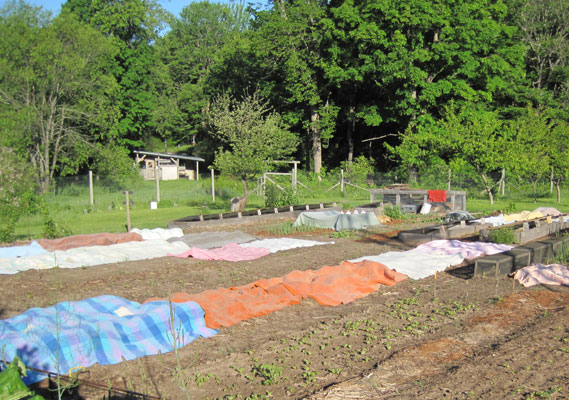 We've
had a short spell of frosty nights and some truly beautiful warm
enough/cool enough sunny days for great working out of doors. Thankfully
the frosts were light though it did require covering a good portion of
the garden for four nights. It's a bit late in the month for frost but
not all that unusual. Many plants are still in their protective cold
frames; easy to manage. But this year with the very unusual heat (we
just don't get 80 degrees in June!) (well, we didn't used to...) things
like potatoes and beans and corn, a good portion of the garden, were up
and running, spurred on by the heat and the rain, and not at all up to
being frosted. So the stack of old garden blankets and sheets were
brought out, with not one extra left over, and everyone made it through
with no damage. Today they were dried and back in storage as the temps
are again rising, with more 80 degree days forecasted. What a
roller-coaster ride.
We've
had a short spell of frosty nights and some truly beautiful warm
enough/cool enough sunny days for great working out of doors. Thankfully
the frosts were light though it did require covering a good portion of
the garden for four nights. It's a bit late in the month for frost but
not all that unusual. Many plants are still in their protective cold
frames; easy to manage. But this year with the very unusual heat (we
just don't get 80 degrees in June!) (well, we didn't used to...) things
like potatoes and beans and corn, a good portion of the garden, were up
and running, spurred on by the heat and the rain, and not at all up to
being frosted. So the stack of old garden blankets and sheets were
brought out, with not one extra left over, and everyone made it through
with no damage. Today they were dried and back in storage as the temps
are again rising, with more 80 degree days forecasted. What a
roller-coaster ride.
Garden Barrier #2 - August 10, 2017
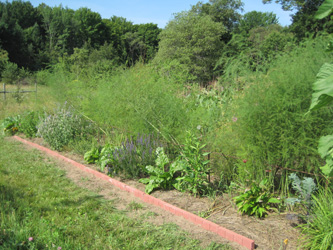 Gardening
is certainly one of my passions and it keeps me well occupied, but summer is
full of other fun and interesting things to do so I've been looking at reducing
some of the chores that don't please me so much, such as keeping the surrounding
vegetation on its own side of the line I've drawn between garden and mowed
area.** We've tilled around the garden, I've mulched around the garden with
various materials, I've let it go and then spent hours pulling grass and sorrel
roots out of the garden beds. There had to be a better way. One was to put in a
barrier and this year we finally did that. Well, I decided and Steve did the
putting. Most trips to Escanaba included a stop at Menards to pick up our quota
of 20 inexpensive paving blocks. That was all we could safely haul in the Prius
at one time. The stack grew and grew until Steve finally did the job, first
along the south border in front of the raspberries. That seems to be working
well so he dug in and went up along the east edge along my new Border Barrier
Bed. (the west edge is waiting for more pavers to arrive, and the north border
will likely wait until next year).
Gardening
is certainly one of my passions and it keeps me well occupied, but summer is
full of other fun and interesting things to do so I've been looking at reducing
some of the chores that don't please me so much, such as keeping the surrounding
vegetation on its own side of the line I've drawn between garden and mowed
area.** We've tilled around the garden, I've mulched around the garden with
various materials, I've let it go and then spent hours pulling grass and sorrel
roots out of the garden beds. There had to be a better way. One was to put in a
barrier and this year we finally did that. Well, I decided and Steve did the
putting. Most trips to Escanaba included a stop at Menards to pick up our quota
of 20 inexpensive paving blocks. That was all we could safely haul in the Prius
at one time. The stack grew and grew until Steve finally did the job, first
along the south border in front of the raspberries. That seems to be working
well so he dug in and went up along the east edge along my new Border Barrier
Bed. (the west edge is waiting for more pavers to arrive, and the north border
will likely wait until next year).
Years ago I had a patch of rhubarb growing behind the compost bins between
them and the yard. It did a great job of keeping the grass back by heavily
mulching that space with their large, thick leaves. I figured rhubarb had to
be the ideal barrier plant but I really didn't want THAT much rhubarb.
Surely there were other plants that would do, so the idea of a border
barrier bed grew. I researched possibilities, imagined outcomes, made lists,
bought a few plants but mostly ended up using what I had. One of the most
challenging areas was along the asparagus bed which is along the east side
of the garden. The grass and sorrel loved to make their way into that
fertile soil and it was hard to get out. So I made a new adjacent bed,
taking some of the asparagus space (there was more than we needed)
(asparagus does not give up its space easily I soon found!) along with the
current path, digging, raking, weeding, reconfiguring the space to suit me -
6 feet wide, half of the width for the asparagus, half for the new bed - so
I can easily reach across to care for both from their respective sides - 45
ft long.
I filled the new bed with plants that will spread out to mulch their space
but not spread so much as to invade the asparagus. At least that's the plan;
we'll see. Some plants will take a few years to spread, others are already
doing their best to fill their space. Mainstay and king of the
mulch-barrier-plot Rhubarb is at either end, in-between sits Oregano,
Russian Sage, Borage, Catnip, Tarragon, Stachys, Hyssop, Helenium,
Coneflower, Lemon Lillies (these I know will need to be thinned often to
keep them in their space - they are amazing spreaders!). In between all I
planted annual Chard and Broccoli to help fill the spaces as the perennials
grow. Chard is doing a great job and may end up being a permanent resident.
But I decided to help the barrier plants by putting in the extra paver block
barrier. Thanks to Steve it actually happened. I like it. It looks a little
more formal (in a homestead kind of way) than I'm used to but I know it will
"rough up" in time. All the plants in the bed are sturdy, simple, varieties
that don't require a lot of fussing and care and are all pollinator
friendly, which was a requirement when choosing what to plant. I'm finding
the asparagus isn't giving up easily and I'm 'weeding' it out of the new bed
as much as I am the resident regular weeds. Disturbing the ground by digging
and tilling is a sure bet way to grow a great crop of new weeds! But I know
this will abate as the new area settles in.
**So what does one call a mowed area that isn't the traditional 'grass lawn'
that most folks think of? We don't have that kind of lawn. We have mowed
vegetation. We have not mowed vegetation. It's all a great diversity of
plants, all sorts of plants and I'm working at adding even more. Some areas
I mow, some I don't, it's all the same; field or lawn, wild or tame; inside
the fence or outside the fence; around the garden, across the orchard,
around the house (or on top of the house!). I haven't yet come up with the
best words for the mowed areas and the not mowed areas of our homestead. If
you have some ideas, let me know!
GARDEN - Looking Forward - January 7, 2017
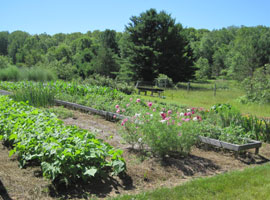 I
enjoy looking back at last season’s garden but mostly I’m looking ahead to the
coming season. What do I want to change, what do I want to do different this
year? Some decisions I don’t make until I’m standing in the garden with plants
or seeds in hand, looking for a good spot for this or that, or a bit of extra
room for just one more whatever. But I do write out a general plan; it helps me
to have an overall idea. Most of what I grow has settled in nicely based on many
years of what we like, what we eat, what grows best, what works here. But
there’s always room for something new. And my biggest change this coming season
will be to add more flowers and herbs and to mix things up a bit. Nothing
exotic, just something more for the pollinators, and for fun.
I
enjoy looking back at last season’s garden but mostly I’m looking ahead to the
coming season. What do I want to change, what do I want to do different this
year? Some decisions I don’t make until I’m standing in the garden with plants
or seeds in hand, looking for a good spot for this or that, or a bit of extra
room for just one more whatever. But I do write out a general plan; it helps me
to have an overall idea. Most of what I grow has settled in nicely based on many
years of what we like, what we eat, what grows best, what works here. But
there’s always room for something new. And my biggest change this coming season
will be to add more flowers and herbs and to mix things up a bit. Nothing
exotic, just something more for the pollinators, and for fun.
I’ve been swimming in a sea full of ideas for the orchard, adding diversity,
looking for understory ideas for the fruit trees, growing towards what some
are calling nowadays a “forest garden”. And I realized I could easily do
more of that in my vegetable garden. The two aren’t really separate, the
roughly 50 x 80 ft vegetable plot being in the middle of the orchard, with
berries in both, but on paper they are separate. And on paper my vegetable
plot is very organized. Some things even stay that way in the garden --
corn, squash, potatoes, tomatoes tend to be in their own 4 x 32 ft plots.
Except for those that end up elsewhere, leftovers when the main plot is
full. And mostly the other crops are in smaller blocks, one next to another.
It’s not that I don’t care for the companion planting idea, or ideal. It’s a
practical thing, that often has to do with frosts.
I’ve had decades of having to suddenly cover tender growing plants when that
late, or early, or mid summer frost is forecast. And I have a supply of old
blankets stored in their own mouse proof cabinet ready for the task. And I
have learned that it is much easier to cover the plants that need protection
if they are all together in one space and not scattered here and there. Been
there and done that! One does get better at these things.
There is actually plenty of diversity and interaction in my garden. When
things get growing I can hardly get through some of the paths between plots,
supposedly there to walk through. It can get to be quite a wonderful jungle.
So why mix things up more? In some cases because it will work better for me.
Snap beans planted in one row along the edge of a plot with something else
in the middle is easier to harvest than a large block of beans, though a
block works well for the dry beans since I only harvest them once. And
spinach definitely likes to be singly along an edge. Coles don’t mind being
in the middle, nor do flowers, at least not the simple ones I grow (zinnia,
marigold, calendula, cosmos). Lettuce can use more shade mid summer so maybe
I’ll put some plants amongst the corn.
I’m a bit tired of the herbs being in one block and most need to be divided
anyway. I think they need to be spread out so one can appreciate them more
as individuals. I’ve started transplanting some out and around and I’ll do
more of that and throughout the garden. I think the vegetables will like
that, too. And why not plant more flowers for the pollinators? I sure do
appreciate them. I’ve ordered borage and nasturtiums. It’s been a long time
since I’ve grown either of those and it’ll be fun to have them again.
One of my favorite flowers is buckwheat. It’s an easy summer loving crop,
and I plant a little here and there as space permits. The bees and such love
it. I let it flower then cut it down when it starts setting seed but there’s
always plenty of volunteers around. It does grow large and rank, and I doubt
anyone would accuse it of being sweet smelling but if the bees like it, I
like it. And I let the broccoli flower for the bees as well. Many of the
common garden vegetables are beautiful “gone to seed”, or flower and well
loved by the pollinators.
It’s not a traditional flower garden by any means, nor the carefully
designed permaculture/polyculture system that seems to be all the rage
nowdays, but something that suits my practical side, my busy summer
schedule, my love of lightly organized wild. I think it will be a fun
garden, and I have no doubt it will feed us well as it has for almost forty
years.
Looking Back -
2016 GARDEN YEAR - January 5, 2017
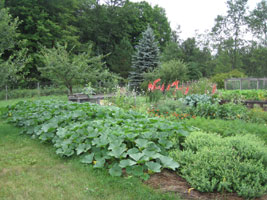 A new year is here with infinite possibilities!
There’s nothing quite like imagining working (playing) in the garden to warm you
up on a cold winter’s evening. It may be zero degrees outside but in my mind
it’s warm and sunny with green things growing all around as I look over my
garden plan. What happened this past season? What worked, what didn’t, what
seeds do I need to grow out this coming year, what do I need to buy? And I
wonder anew at the abundant food that garden gave us. It’s always amazing but
this year was over the top for some of the more heat loving crops.
A new year is here with infinite possibilities!
There’s nothing quite like imagining working (playing) in the garden to warm you
up on a cold winter’s evening. It may be zero degrees outside but in my mind
it’s warm and sunny with green things growing all around as I look over my
garden plan. What happened this past season? What worked, what didn’t, what
seeds do I need to grow out this coming year, what do I need to buy? And I
wonder anew at the abundant food that garden gave us. It’s always amazing but
this year was over the top for some of the more heat loving crops.
Every year is different; that is one thing I can always depend on! And this
past year it was record warmth. I usually figure, roughly, a frost free
growing season from about the 2nd week in June till the first or second week
in September. This year we had a mild spring, with a last frost mid May,
then just one freeze June 7. Then we didn’t have another frost (freeze
actually) until October 9. In between was unusually warm with plenty of
rain. The corn and squash were beside themselves with joy and enthusiasm.
And the sunflowers turned into trees that I almost had to get out an axe to
cut down. The squash I grow is a relatively short season buttercup variety I
got from Kathleen Plunket-Black of Plum Creek Seeds, a long time and very
experienced seed saver in Arkansas WI. It’s rich, sweet and nutty, and I
usually get a reasonable crop with maybe half the fruit maturing before
frost. So I plant with that in mind. But this year not only did the vines
grow with abandon setting fruit right and left (thankfully along the edge of
the garden so they could sprawl out over the grass), every single one,
except for one half grown late specimen, fully matured. Wow, did we have
squash this year! I make a bit of squash soup but our favorite is to have
plain cooked squash with our luncheon salad, almost every day. We never tire
of it.
By contrast, two years ago we had a long, cool, wet spring and early summer.
Fruit set was poor for many crops including the squash and cucumbers. The
harvest was sparse to pathetic, and the big question among gardeners was
“did you get any cucumbers? any squash?”. It was a rare one who did. Not
even zucchini. Then this year one could hardly give cucumbers away. It was
the year to make pickles for sure. I didn’t have any trouble finding homes
for the extra winter squash though. It found its way into many a
Thanksgiving dinner for which I was very thankful. Make hay while the sun
shines, as they say, and eat squash when you have it. We do, and we are,
along with a very appreciated abundance of other vegetables.
Copyright © Susan Robishaw


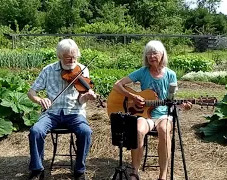
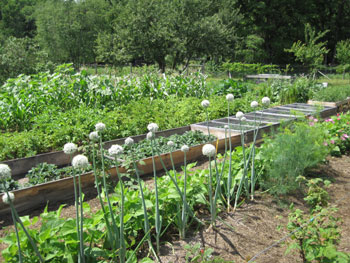
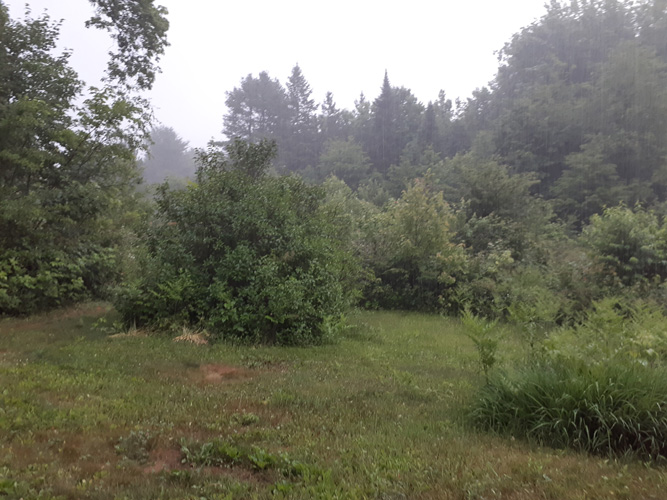
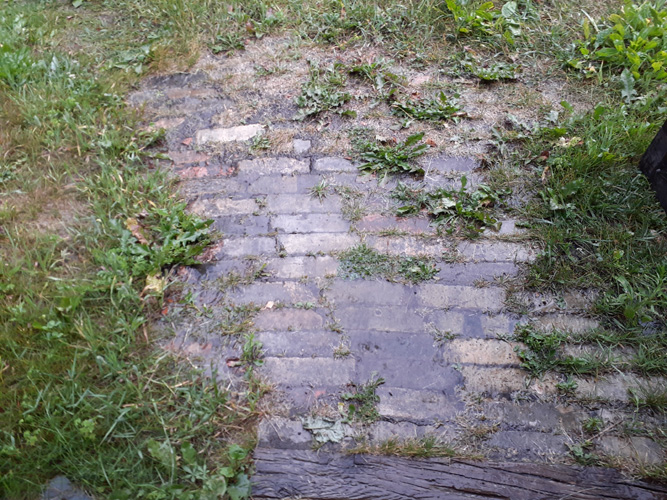
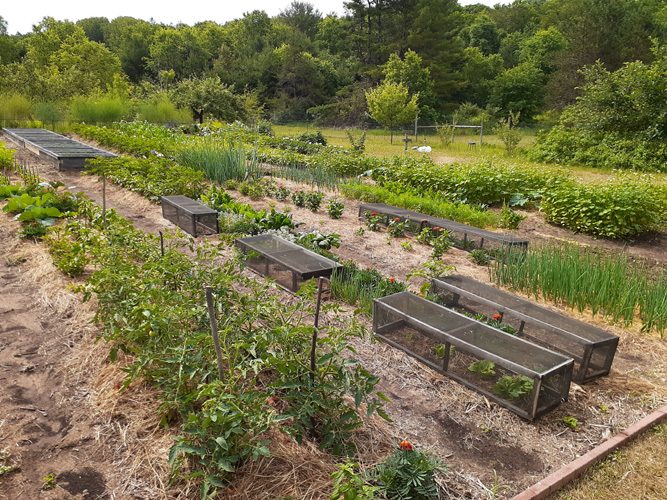
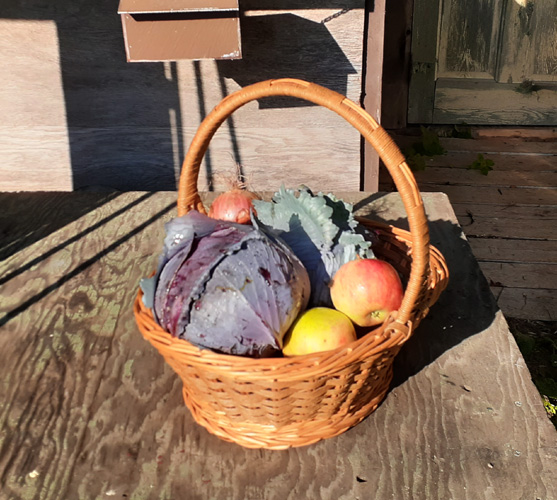
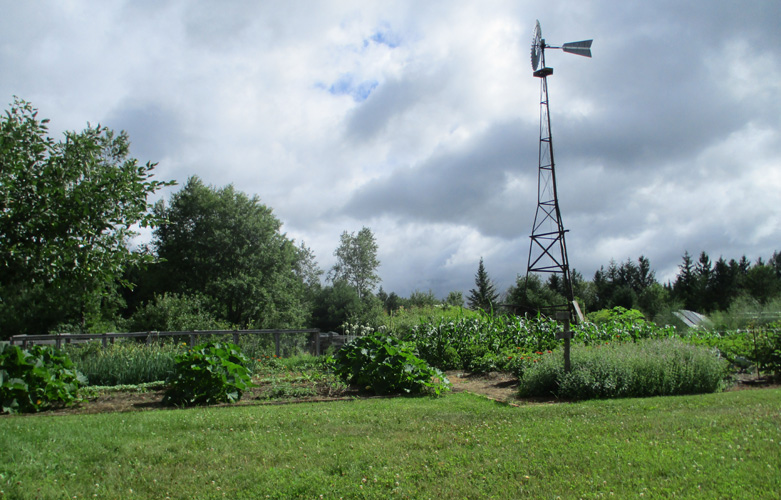

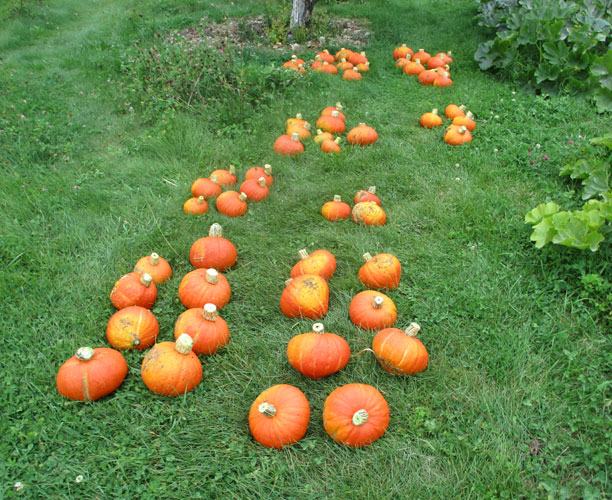 What a growing season. After the spring drought and a few late frosts
and freezes it continued on unusually hot with enough rain to keep
things growing. And they did grow! With no frost until mid October there
was no concern about crops maturing, even tomatoes. The big comments at
the Farmers Markets in July was how tall everyone's corn was, and the
crop came early. My winter squash was so enthusiastic I spent the fall
giving away squash to anyone who would take it. Everyone had a lot of
squash this year. In spite of the late onset of frost the fall was
fairly "normal" with the usual variable weather which was nice, and
comfortable.
What a growing season. After the spring drought and a few late frosts
and freezes it continued on unusually hot with enough rain to keep
things growing. And they did grow! With no frost until mid October there
was no concern about crops maturing, even tomatoes. The big comments at
the Farmers Markets in July was how tall everyone's corn was, and the
crop came early. My winter squash was so enthusiastic I spent the fall
giving away squash to anyone who would take it. Everyone had a lot of
squash this year. In spite of the late onset of frost the fall was
fairly "normal" with the usual variable weather which was nice, and
comfortable. 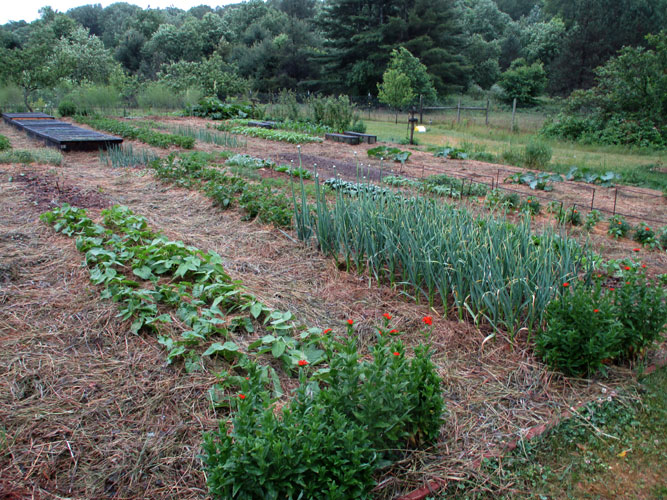
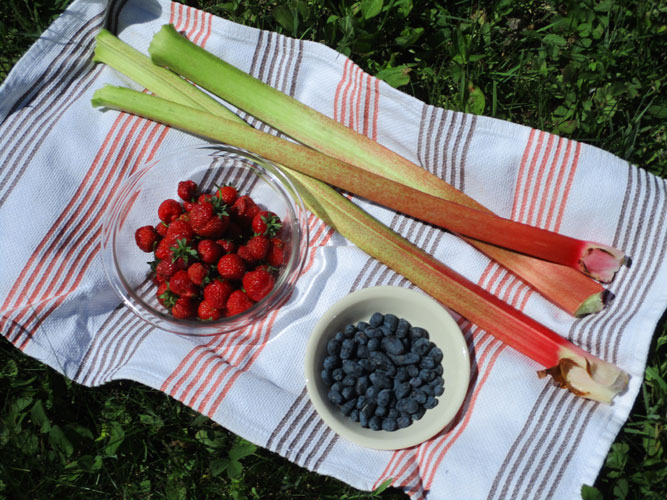 There
will be few if any apples this year thanks to the four-night
frost-freeze event (right after my enthusiastic apple blooming post
below) but there are strawberries (well covered during those freezes)
and haskaps and the blueberry crop is looking good. And there is always
the hardy rhubarb, tinged but not defeated by the freezes. I have to
admit that with the extended local drought the apple trees are no doubt
better off without having to try to produce a crop this year. It all
works out in the end.
There
will be few if any apples this year thanks to the four-night
frost-freeze event (right after my enthusiastic apple blooming post
below) but there are strawberries (well covered during those freezes)
and haskaps and the blueberry crop is looking good. And there is always
the hardy rhubarb, tinged but not defeated by the freezes. I have to
admit that with the extended local drought the apple trees are no doubt
better off without having to try to produce a crop this year. It all
works out in the end.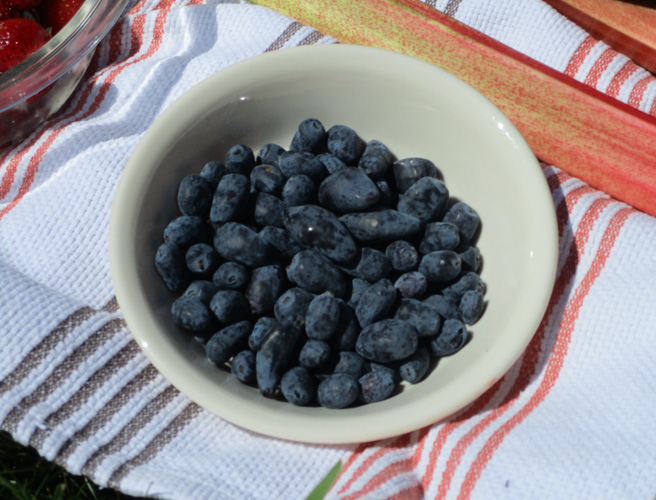 The
haskaps are fun this year as this is the first year I'm getting enough
to pick more than a sampling from the older (though still young) plants.
And some of the youngest of the eight varieties I have are setting fruit
for the first time so I get a taste of the differences between them all.
They are mostly quite similar but ripen at different times so there is a
fairly long season of harvest. They are an interesting fruit, aka
honeyberries but they aren't as sweet as that name hints. They are more
on the sour side, especially when not quite ripe, so one has to let them
hang on the bush until they are ready to fall off and you hope to get
them before the birds (or chipmunks) do. A bit of an odd look to them
but they are an early and much appreciated fruit. And even better --
they are very hardy! They are doing just fine with all this crazy
weather. They just keep on truckin' and that's a good way to go. There
is always something good happening in the homestead garden and orchard.
The
haskaps are fun this year as this is the first year I'm getting enough
to pick more than a sampling from the older (though still young) plants.
And some of the youngest of the eight varieties I have are setting fruit
for the first time so I get a taste of the differences between them all.
They are mostly quite similar but ripen at different times so there is a
fairly long season of harvest. They are an interesting fruit, aka
honeyberries but they aren't as sweet as that name hints. They are more
on the sour side, especially when not quite ripe, so one has to let them
hang on the bush until they are ready to fall off and you hope to get
them before the birds (or chipmunks) do. A bit of an odd look to them
but they are an early and much appreciated fruit. And even better --
they are very hardy! They are doing just fine with all this crazy
weather. They just keep on truckin' and that's a good way to go. There
is always something good happening in the homestead garden and orchard. May
18, 2021 -- First Asparagus
May
18, 2021 -- First Asparagus 

 Squash
had a late start getting going this year, maybe due to the unusual
record heat so I didn't know if there would be any ripe ones. But I had
detected some orange amongst the very lush large leaves so I hoped.
Turns out there was no need to worry, they loved this over-hot summer
and made record time ripening. I think we'll have enough squash! There
were five not quite ripe good sized fruit left in the plants so I
double-blanket covered those to see if they can make it.
Squash
had a late start getting going this year, maybe due to the unusual
record heat so I didn't know if there would be any ripe ones. But I had
detected some orange amongst the very lush large leaves so I hoped.
Turns out there was no need to worry, they loved this over-hot summer
and made record time ripening. I think we'll have enough squash! There
were five not quite ripe good sized fruit left in the plants so I
double-blanket covered those to see if they can make it. 
 We've
had a short spell of frosty nights and some truly beautiful warm
enough/cool enough sunny days for great working out of doors. Thankfully
the frosts were light though it did require covering a good portion of
the garden for four nights. It's a bit late in the month for frost but
not all that unusual. Many plants are still in their protective cold
frames; easy to manage. But this year with the very unusual heat (we
just don't get 80 degrees in June!) (well, we didn't used to...) things
like potatoes and beans and corn, a good portion of the garden, were up
and running, spurred on by the heat and the rain, and not at all up to
being frosted. So the stack of old garden blankets and sheets were
brought out, with not one extra left over, and everyone made it through
with no damage. Today they were dried and back in storage as the temps
are again rising, with more 80 degree days forecasted. What a
roller-coaster ride.
We've
had a short spell of frosty nights and some truly beautiful warm
enough/cool enough sunny days for great working out of doors. Thankfully
the frosts were light though it did require covering a good portion of
the garden for four nights. It's a bit late in the month for frost but
not all that unusual. Many plants are still in their protective cold
frames; easy to manage. But this year with the very unusual heat (we
just don't get 80 degrees in June!) (well, we didn't used to...) things
like potatoes and beans and corn, a good portion of the garden, were up
and running, spurred on by the heat and the rain, and not at all up to
being frosted. So the stack of old garden blankets and sheets were
brought out, with not one extra left over, and everyone made it through
with no damage. Today they were dried and back in storage as the temps
are again rising, with more 80 degree days forecasted. What a
roller-coaster ride. Gardening
is certainly one of my passions and it keeps me well occupied, but summer is
full of other fun and interesting things to do so I've been looking at reducing
some of the chores that don't please me so much, such as keeping the surrounding
vegetation on its own side of the line I've drawn between garden and mowed
area.** We've tilled around the garden, I've mulched around the garden with
various materials, I've let it go and then spent hours pulling grass and sorrel
roots out of the garden beds. There had to be a better way. One was to put in a
barrier and this year we finally did that. Well, I decided and Steve did the
putting. Most trips to Escanaba included a stop at Menards to pick up our quota
of 20 inexpensive paving blocks. That was all we could safely haul in the Prius
at one time. The stack grew and grew until Steve finally did the job, first
along the south border in front of the raspberries. That seems to be working
well so he dug in and went up along the east edge along my new Border Barrier
Bed. (the west edge is waiting for more pavers to arrive, and the north border
will likely wait until next year).
Gardening
is certainly one of my passions and it keeps me well occupied, but summer is
full of other fun and interesting things to do so I've been looking at reducing
some of the chores that don't please me so much, such as keeping the surrounding
vegetation on its own side of the line I've drawn between garden and mowed
area.** We've tilled around the garden, I've mulched around the garden with
various materials, I've let it go and then spent hours pulling grass and sorrel
roots out of the garden beds. There had to be a better way. One was to put in a
barrier and this year we finally did that. Well, I decided and Steve did the
putting. Most trips to Escanaba included a stop at Menards to pick up our quota
of 20 inexpensive paving blocks. That was all we could safely haul in the Prius
at one time. The stack grew and grew until Steve finally did the job, first
along the south border in front of the raspberries. That seems to be working
well so he dug in and went up along the east edge along my new Border Barrier
Bed. (the west edge is waiting for more pavers to arrive, and the north border
will likely wait until next year). I
enjoy looking back at last season’s garden but mostly I’m looking ahead to the
coming season. What do I want to change, what do I want to do different this
year? Some decisions I don’t make until I’m standing in the garden with plants
or seeds in hand, looking for a good spot for this or that, or a bit of extra
room for just one more whatever. But I do write out a general plan; it helps me
to have an overall idea. Most of what I grow has settled in nicely based on many
years of what we like, what we eat, what grows best, what works here. But
there’s always room for something new. And my biggest change this coming season
will be to add more flowers and herbs and to mix things up a bit. Nothing
exotic, just something more for the pollinators, and for fun.
I
enjoy looking back at last season’s garden but mostly I’m looking ahead to the
coming season. What do I want to change, what do I want to do different this
year? Some decisions I don’t make until I’m standing in the garden with plants
or seeds in hand, looking for a good spot for this or that, or a bit of extra
room for just one more whatever. But I do write out a general plan; it helps me
to have an overall idea. Most of what I grow has settled in nicely based on many
years of what we like, what we eat, what grows best, what works here. But
there’s always room for something new. And my biggest change this coming season
will be to add more flowers and herbs and to mix things up a bit. Nothing
exotic, just something more for the pollinators, and for fun.
 A new year is here with infinite possibilities!
There’s nothing quite like imagining working (playing) in the garden to warm you
up on a cold winter’s evening. It may be zero degrees outside but in my mind
it’s warm and sunny with green things growing all around as I look over my
garden plan. What happened this past season? What worked, what didn’t, what
seeds do I need to grow out this coming year, what do I need to buy? And I
wonder anew at the abundant food that garden gave us. It’s always amazing but
this year was over the top for some of the more heat loving crops.
A new year is here with infinite possibilities!
There’s nothing quite like imagining working (playing) in the garden to warm you
up on a cold winter’s evening. It may be zero degrees outside but in my mind
it’s warm and sunny with green things growing all around as I look over my
garden plan. What happened this past season? What worked, what didn’t, what
seeds do I need to grow out this coming year, what do I need to buy? And I
wonder anew at the abundant food that garden gave us. It’s always amazing but
this year was over the top for some of the more heat loving crops.